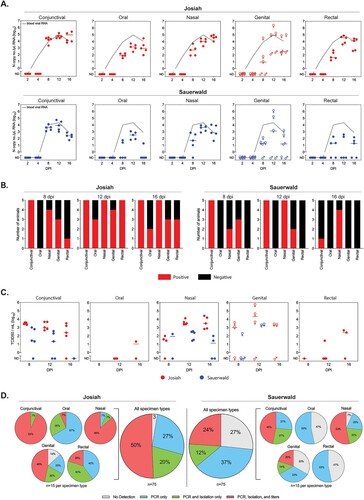Figures & data
Figure 1. Analysis of mucosal specimens from Lassa virus-infected strain 13/N guinea pigs. Groups of 25 animals were inoculated subcutaneously with LASV strain Josiah or strain Sauerwald (target dose: 1 × 104 FFU), and 5 animals per experimental group were serially euthanized at 1 of 5 pre-determined timepoints. Five paired swab specimens were collected per animal, one for RT-qPCR and the other for virus isolation and titration. (A) Levels of LASV RNA (N gene copy no./µL) in individual swab specimens are represented as dots (line at median), and median levels in EDTA whole blood specimens from groups of animals serially euthanized at the indicated timepoints are shown as dotted black line. For genital samples, values from samples collected from females (♀; intravaginal) and males (♂; preputial) are indicated. (B) Virus isolation was attempted with all swab specimens collected 8, 12, and 16 days post infection (dpi; n = 150). Red indicates proportion of samples from which virus was isolated; black indicates proportion of samples without isolatable virus. (C) Virus titration (TCID50/mL) was performed on all swab specimens collected 8, 12, and 16 dpi from which virus was isolated (n = 80). Some isolate-positive samples were below limit of detection in titration assays. For genital samples, values from females (♀; intravaginal) and males (♂; preputial) are indicated. (D) Summary of sample analyses. Total proportion of swab samples obtained 8, 12, and 16 dpi from Josiah- (n = 75) or Sauerwald-infected (n = 75) animals with no LASV detected (grey), or LASV detected by PCR alone (blue), PCR and virus isolation (green), or PCR, virus isolation, and virus titration (red). Samples are further broken down by both strain and specimen type, representing the 15 individual specimens for each sample type analysed. ND, not detected.

